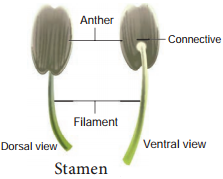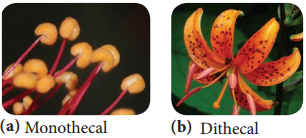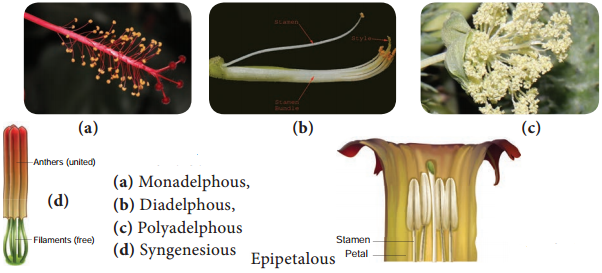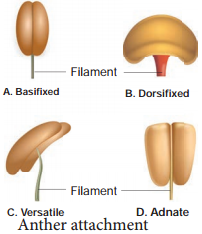Learninsta presents the core concepts of Biology with high-quality research papers and topical review articles.
Androecium – Definiton of Androecium and its Various Types
Androecium:
Third whorl of flower is the male reproductive part of the flower. It is composed of stamens (microsporophylls).
Each Stamen consist of 3 parts:
- Filament
- Anther
- Connective
Anther:
Upper swollen part with microsporangia.
Filament:
Stalk of stamen
Connective:
Tissue connecting anther lobes with filament

Anther typically contains two compartments called thecae (singular theca). Each theca consists of two microsporangia. Two microsporangia fused to form a locule. Sterile stamens are called Staminodes. Example: Cassia. Distinct: stamens which do not fuse to one another. Free: stamens which do not fuse with other parts of flower. Apostemonous: flowers with stamens that are free and distinct.
Fusion of Stamens:
The fusion of stamens fusing among themselves or with other parts of flower. They are of two types.
- Connation and
- Adnation
1. Connation:
Refers to the fusion of stamens among themselves. It is of 3 types:-
- Adelphy
- Syngenecious
- Synandrous
Adelphy:
Filaments connate into one or more bundles but anthers are free. It may be the following types.
(i) Monadelphous:
Filaments of stamens connate into a single bundle. Example: Malvaceae (Chinarose, Cotton).
(ii) Diadelphous:
Filaments of stamens connate into two bundles. Example: Fabaceae (pea) and Clitoria.
(iii) Polyadelphous:
Filaments connate into many bundles. Example: Citrus, Bombax
Syngenesious:
Anthers connate, filaments free. Example: Asteraceae.
Synandrous:
Filaments and anthers are completely fused. Example: Coccinea.
2. Adnation:
Refers to the fusion of stamens with other flral parts. Epipetalous: Stamens are adnate to petals. Example: Brinjal, Datura.
a. Episepalous:
Stamens are adnate to sepals. Example: Grevillea (Silver oak)
b. Epitepalous (Epiphyllous):
Stamens are adnate to tepals. Example: Asparagus.
c. Gynostegium:
Connation product of stamens and stigma is called gynostegium. Example: Calotropis and Orchidaceae.
d. Pollinium:
Pollen grains are fused together as a single mass Example: Calotropis
Arrangement of stamens relate to length of stamens:
1. Didynamous:
Four stamens of which two with long fiaments and two with short filaments. Example: Ocimum
2. Tetradynamous:
Six stamens of which four with long filaments and two with short filaments. Example: Brassica.
3. Heterostemonous:
Stamens are of different lengths in the same flower. Example: Cassia.
Anther Types
1. Monothecal:
One lobe with two microsporangia. They are kidney shaped in a cross section. Example: Malvaceae

2. Dithecal:
It is a typical type, having two lobes with four microsporangia. They are butterfly shaped in cross section. Example: Solanaceae.
Anther Attachment
1. Basifixed:
(Innate) Base of anther is attached to the tip of filament. Example: Datura.
2. Dorsifixed:
Apex of filament is attached to the dorsal side of the anther. Example: Hibiscus.
3. Versatile:
Filament is attached to the anther at midpoint. Example: Grasses.
4. Adnate:
Filament is continued from the base to the apex of anther. Example: Nelumbo

